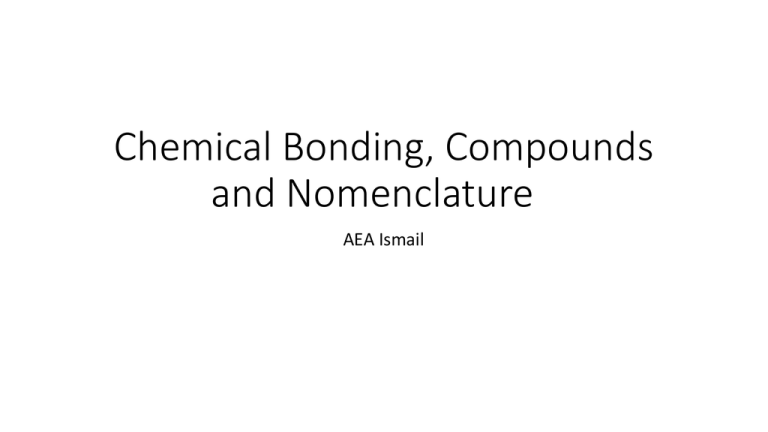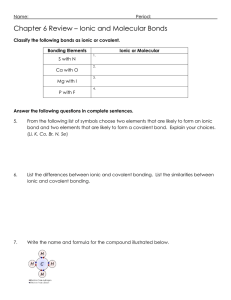Chemical Bonding, Compounds and Nomenclature
advertisement

Chemical Bonding, Compounds and Nomenclature AEA Ismail Learning Objectives After this section you should be able to : 1. Predict the type of bond formed within a compound 2. Give the correct chemical formula for compound 3. Compare and Contrast Ionic and Covalent bonding and the resulting comounds. 4. Give the correct chemical name for a given chemical formula Bonding • All chemical reactions create or break bonds. When bonds are made and broken energy is either needed or required. • Review : A chemical change is a change that involves the creation of new matter. When new matter is created bonds have to be either broken or created or both. • Why do you think atoms want to bond?? What particles found in the atom are involved in bonding? Bonding • Bonding is all about ELECTRONS • There are two ways in which bonds can form: 1. Transferred – Ionic Bonding 2. Shared - Covalent Bonding Atoms bonds because they want to get a full outer shell(Octet Rule – 8 electrons) Ionic Bonding Ionic Bonding is when electrons are transferred between two atoms. • Usually occurs between a metal and a non-metal • Forms a three-dimensional lattice How to determine the Chemical Formula of an Ionic Compound • Step 1: you have to determine the charge of the individual elements involved, for instance if we have Al and Cl. • Al=+3 Cl=-1 • Step 2 : Crossing the numbers. This means that you take the 3 from the Al and put it as the subscript for Cl and the 1 from Cl and put it as the subscript for Al. Then you get rid of the charges. • Chemical Formula : AlCl3 A chemical formula is the way of expressing the proportions of the atoms within the molecule/compound. For instance, above there are 3 Chlorines for every 1 Aluminum. Why you may ask? Why does it form AlCl3 Naming Ionic Bonded Compounds • Step 1:identify if the compound is an ionic compound. If it does then it is an ionic compound. • Step 2: Write down the metal first followed by the non-metal, but you change the ending of the non-metal to –ide. • For example – CsF - Cesium Floride • MgO – Magnesium Oxide • Ca3P2- Calcium Phosphide Ionic Formula Practice Predict the formula for the following : 1. Aluminium Phosphide 2. Gallium Sulfide 3. Sodium Oxide 4. Barium Fluoride 5. Potassium Chloride Predict the Name of the Following Compounds • Identify the Chemical name for the following compounds : 1. AlS 2. In2O3 3. Cs2Se 4. Mg0 5. CaCl2 Covalent Bonding • Covalent Bonding is when electrons are shared between two atoms. • Occurs between two non-metals • Forms small individual molecules to three-dimensional lattices • Depends on the atoms involved and the arrangement Carbon vs Diamond These two covalent compounds have the same chemical formula, but different structures. Graphite has a molecular structure, while diamond has a threedimensional lattice structure How to Name a Covalent Bonded Molecule Step 1 : Identify whether the compound is ionic or covalent. If it is covalent right down what you have, but change the ending of the second non-metal to –ide. Step 2: Add Prefixes before the elements to symbolize how many of each element we have. (Note, mono is not used for the first element) Ex.. CO3 – Carbon Trioxide S2O3 – Disulfur Trioxide Covalent Naming Practice Name the following 1. NO2 2. C2S5 3. PO 4. Se2O3 5. C5H8 Predict the Chemical Formula What is the chemical formula for the following? 1. Tetracarbon Monohydride 2. Disulfur Trifloride 3. Nitrogen Trihyride 4. Carbon Manoxide 5. Sulfur dioxide Drawing Simple Diatomic Covalent Bonded Molecules • Please Draw a molecule of O2 Simplified Rules for Drawing Simple Covalent Molecules (More complex rules in chemistry) All the molecules you will draw are diatomic molecules of the same element. 1. Draw the outer shell (valence electrons) of the atoms involved. 2. A covalent bond involves the sharing of two electrons, 1 by each atom. Therefore, every time one atom shares the other atom has to share. --- 3. For each pair of shared electrons we draw a bond, which is a line. To determine how many shared electrons we think about how many electrons it takes to fill up the outer shell. Therefore atoms share electrons until both atoms are happy enough and their outer shells are full. Draw F2 Draw N2


